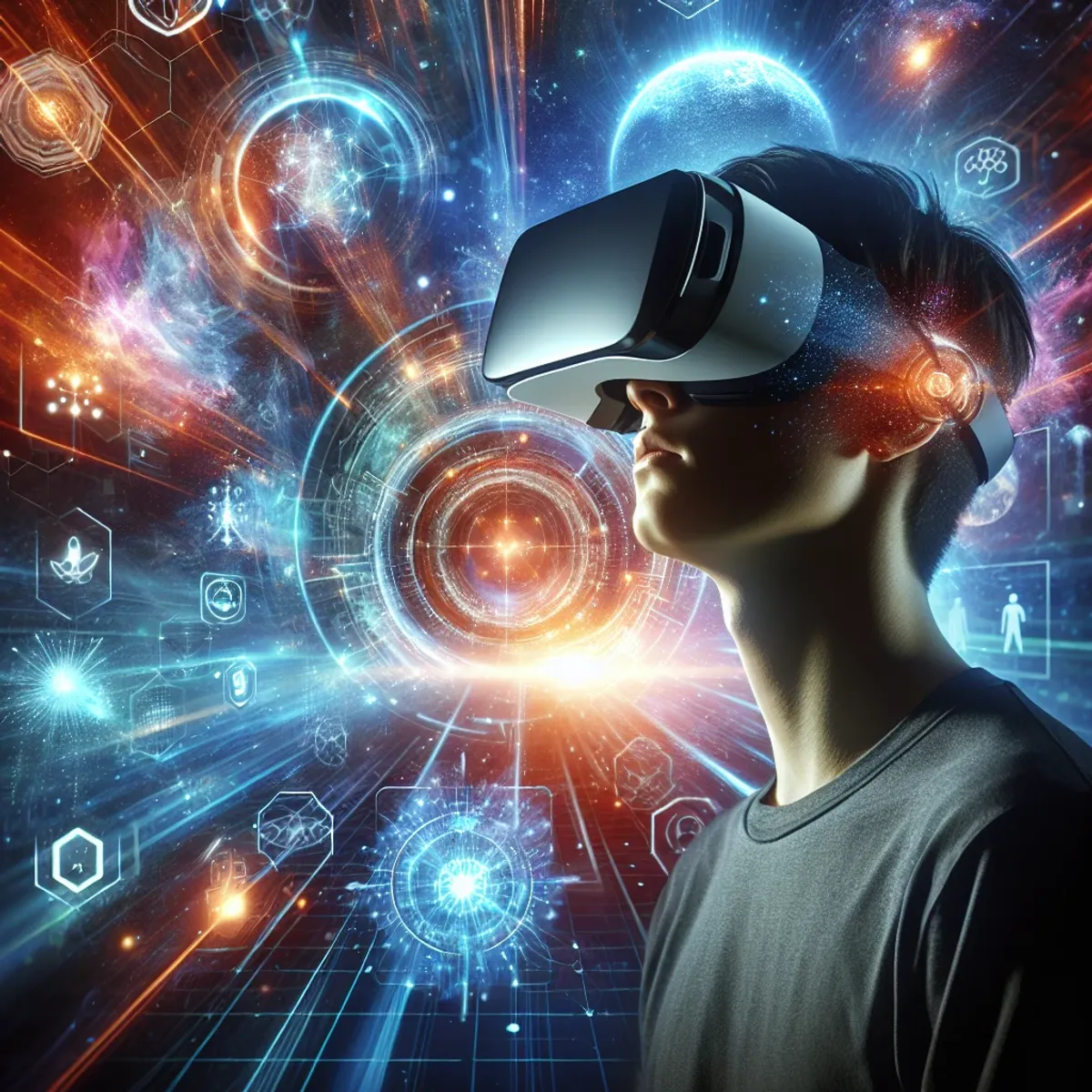Virtual Reality in Healthcare: What You Need to Know

Introduction
Virtual reality (VR) is changing the healthcare industry by providing new solutions that improve patient care and treatment results. By putting users in a simulated environment, VR technology creates an experience that has many uses in healthcare.
Table of ContentsWhat is Virtual Reality?
At its core, virtual reality is a computer-generated environment that imitates the real world or an imagined place. It usually involves wearing a headset that shows three-dimensional images and may include other sensory inputs like sound and touch. In healthcare, VR is used in different medical areas to tackle problems and improve patient results.
The Benefits of Virtual Reality in Healthcare
The advantages of virtual reality in healthcare are numerous:
-
Training Healthcare Professionals: VR offers a safe and controlled space for healthcare professionals to practice difficult procedures without risking patients' well-being.
-
Therapeutic Interventions: VR can enhance therapy by increasing patient involvement and motivation. By immersing patients in interactive experiences, VR therapy provides a more enjoyable and effective approach to treatment.
Impact of Virtual Reality in Healthcare
The use of virtual reality in healthcare is expanding rapidly:
-
The healthcare VR market is expected to be worth billions of dollars soon.
-
Advancements in technology are driving this growth.
-
Hospitals and medical institutions are increasingly adopting VR.
This growth highlights the importance of exploring the different uses of VR in healthcare.
In this article, we will explore the various applications of virtual reality in healthcare. From training surgeons and simulating surgeries, to managing pain, aiding rehabilitation, facilitating telemedicine, and more, we will examine how VR is changing these aspects of healthcare delivery. Join us as we discover the exciting possibilities of virtual reality in transforming healthcare practices and enhancing patient results.
1. Virtual Reality in Surgical Training and Simulation
Surgical training is a critical aspect of medical education, and virtual reality (VR) technology has revolutionized this field. VR allows for highly realistic surgical simulations that provide trainees with immersive experiences, enabling them to develop their skills in a safe and controlled environment.
Realistic Surgical Simulations
VR technology has made significant advancements in creating realistic surgical simulations. Trainees can now engage in hands-on practice with virtual patients, replicating the intricacies of real-life surgical procedures. By using VR headsets and motion-tracking devices, medical students and surgeons can perform operations virtually, mimicking the actual physical movements required in surgery.
Benefits of VR Surgical Simulations.
Risk-free practice: VR simulations provide a safe environment for trainees to practice surgical techniques without any risk to patients' lives. Mistakes made during the simulation can be used as valuable learning opportunities without adverse consequences.
Realistic scenarios: Virtual reality allows for the creation of lifelike scenarios that closely resemble actual surgical procedures. Trainees can encounter unexpected complications, learn how to manage them effectively, and gain confidence in their ability to handle challenging situations.
Repetition and feedback: VR simulations offer trainees the opportunity to repeat procedures multiple times, refining their skills and improving their performance. Additionally, instant feedback from virtual mentors or instructors enhances the learning process by highlighting areas for improvement.
One notable example of VR in surgical training is the Osso VR platform. This platform provides realistic simulations for orthopedic surgery, allowing surgeons to practice procedures such as joint replacements or fracture fixations. The immersive nature of the simulations enables trainees to develop muscle memory and gain confidence before performing surgeries on real patients.
1.2 Improved Surgical Skills and Efficiency
VR technology has shown great promise in improving surgical skills and efficiency through immersive training programs. Several studies and cases have demonstrated clear improvements in surgeons' technical abilities after they received training using VR.
Benefits of VR for Surgical Training:
Safe and Controlled Environment: VR creates a safe and controlled setting for practice, allowing trainees to experience realistic surgical situations without any risks to real patients.
Repetitive Practice: Trainees can participate in repeated practice sessions, refining their skills in specific procedures or techniques without any time constraints or worries about patient safety.
Studies and Cases Showing Improvement:
Research studies have documented measurable enhancements in surgeons' dexterity, hand-eye coordination, and overall procedural performance following VR-based training programs. Specific cases within healthcare institutions have reported reduced error rates and shorter operating times among surgeons who underwent VR simulations for surgical skill development. The incorporation of VR into surgical training has the potential to transform traditional methods by providing a dynamic and risk-free learning environment that leads to better clinical outcomes.
2.1 Enhanced Engagement and Motivation in Therapy
Virtual reality (VR) can make therapy more engaging and motivating for patients, which can lead to better treatment results. Here's how VR therapy works:
Creating an immersive experience
VR technology allows therapists to create virtual environments that are tailored to each patient's needs.These virtual environments include visual, auditory, and even touch feedback to make them feel realistic. This makes the therapy session more immersive and enjoyable for the patient.
Increasing motivation
Traditional therapy methods can sometimes be boring or repetitive, which can demotivate patients. With VR therapy, patients are transported into interactive and dynamic virtual worlds. These virtual worlds are designed to be fun and challenging, which keeps patients motivated to participate.
Facilitating exposure therapy
VR is especially useful for exposure therapy, where patients confront their fears in a controlled setting. For example, someone with a fear of heights can use VR to gradually expose themselves to tall buildings or cliffs. This allows them to practice facing their fear in a safe environment before doing it in real life.
Encouraging active participation
In traditional therapy, patients often just listen or talk while the therapist does most of the work. But with VR therapy, patients become active participants in their own healing process. They can explore virtual environments, interact with objects or characters, and engage in therapeutic activities.
Improving treatment outcomes
Research has shown that VR therapy can be effective for treating various mental health conditions. It has been used successfully for anxiety disorders, phobias, post-traumatic stress disorder (PTSD), and chronic pain management. The immersive and interactive nature of VR therapy seems to help patients better engage with the treatment, leading to better results. By using VR technology in therapy sessions, therapists can create a more engaging and motivating experience for their patients. This has the potential to improve treatment outcomes for a wide range of conditions.
2.2 Remote Rehabilitation Using Virtual Reality

Virtual reality (VR) technology has the potential to revolutionize the delivery of rehabilitation services, particularly in underserved areas or during situations like a pandemic. Here are some key points about remote rehabilitation using virtual reality:
Access to Rehabilitation Services
VR allows patients to access rehabilitation services remotely, eliminating the need for frequent visits to healthcare facilities. This is especially beneficial for individuals who live in remote areas with limited access to specialized rehabilitation centers.
Increased Engagement and Adherence
Traditional rehabilitation exercises can be repetitive and monotonous, leading to decreased patient motivation and adherence. However, VR offers interactive and engaging experiences through immersive environments and motion-enabled games. This increased engagement can motivate patients to actively participate in their rehabilitation programs and adhere to treatment plans.
Personalized Rehabilitation
VR technology allows for personalized rehabilitation programs tailored to individual patient needs. Therapists can create customized virtual environments and exercises that target specific areas of improvement. This personalized approach enhances the effectiveness of rehabilitation by focusing on each patient's unique requirements.
Real-Time Monitoring and Feedback
With VR, therapists can remotely monitor patients' progress in real-time. Sensors built into VR devices can track movements and provide immediate feedback on performance. This real-time monitoring ensures that patients receive optimal care even when not physically present with their healthcare providers.
Cost-Effective Solution
Remote rehabilitation using VR can be a cost-effective solution compared to traditional in-person therapy sessions. It eliminates the need for extensive travel costs and reduces the burden on healthcare facilities. Additionally, patients can continue their rehabilitation at home, minimizing the need for prolonged hospital stays or outpatient visits. Overall, VR offers a promising solution for remote rehabilitation, enabling patients to access high-quality care from the comfort of their own homes. It enhances engagement, provides personalized treatment options, and offers real-time monitoring and feedback. By leveraging the power of VR, healthcare providers can extend their reach and improve the accessibility of rehabilitation services to a broader population.
3.1 Use of VR for Pain Reduction and Distraction
- Virtual Reality (VR) has shown promising potential in the healthcare industry, particularly in the realm of pain management. By creating immersive experiences, VR technology can effectively divert patients' attention away from painful stimuli, thereby reducing their perception of pain. This distraction technique has been utilized in various medical procedures and therapies to enhance patient comfort and minimize the need for traditional pain management interventions.
Applications of VR in Pain Reduction
One notable application of VR for pain reduction is during: Wound care procedures or physical therapy sessions & Managing acute procedural pain during medical interventions.
Benefits of VR-based Distractions
Furthermore, research has indicated that VR-based distractions can lead to:
- Decreased pain intensity.
- Lower distress levels.
The immersive nature of VR experiences has the potential to transform the way healthcare professionals address acute and chronic pain, providing patients with alternative coping mechanisms and enhancing overall treatment outcomes. The use of VR for pain reduction aligns with the broader movement towards holistic and patient-centered care, offering innovative solutions for improving the quality of life for individuals dealing with various medical conditions. As technology continues to advance, the integration of VR into pain management protocols is poised to make a significant impact on patient well-being across diverse healthcare settings.
Enhancing Mental Health Outcomes Through Virtual Reality
Virtual reality (VR) has shown great potential as a therapeutic tool for improving mental health outcomes in various conditions, including anxiety disorders and post-traumatic stress disorder (PTSD). By creating immersive experiences, VR can provide a safe and controlled environment for individuals to confront and manage their fears and anxieties.
Exposure Therapy
VR can be used to expose individuals to situations or stimuli that trigger anxiety or trauma in a controlled and gradual manner. For example, someone with a fear of flying can undergo virtual flight simulations, allowing them to gradually confront their fear and build resilience. This exposure therapy has been shown to be effective in reducing symptoms of anxiety disorders and PTSD.
4. Virtual Reality in Telemedicine and Remote Healthcare
Virtual reality (VR) is revolutionizing the field of telemedicine, enabling healthcare professionals to provide remote care and consultations to patients who are geographically distant from each other. The applications of VR in telemedicine are vast, offering numerous benefits to both patients and healthcare providers. key points to consider:
Facilitating Virtual Consultations
VR technology allows doctors and specialists to virtually connect with patients in real-time, regardless of their physical location. Through immersive headsets and advanced communication tools, healthcare professionals can conduct thorough examinations, diagnose conditions, and prescribe treatments remotely.
Improving Access to Healthcare
VR in telemedicine addresses the issue of accessibility by providing medical services to individuals who may have limited access to healthcare facilities due to geographical constraints, mobility issues, or lack of resources. It bridges the gap between patients and doctors, ensuring that quality healthcare is accessible to all.
Enhancing Patient Engagement
Telemedicine consultations can sometimes feel impersonal or detached. However, VR adds a new dimension to remote healthcare by creating a more immersive and engaging experience for patients. Through virtual environments and interactive simulations, patients can actively participate in their own care, resulting in increased engagement and better treatment outcomes.
Reducing Healthcare Costs
By leveraging VR technology in telemedicine, healthcare providers can significantly reduce costs associated with traditional in-person consultations. Travel expenses for both patients and doctors are eliminated, waiting times are minimized, and overall operational costs are reduced. This not only benefits healthcare organizations but also makes healthcare more affordable for patients.
Expanding Specialized Care
Virtual reality enables specialists to offer their expertise beyond their physical location. Through telemedicine with VR, patients can receive specialized care from renowned experts without the need for travel or referrals. This expands access to specialized treatments and improves patient outcomes.
The integration of virtual reality into telemedicine is transforming the way healthcare is delivered. It enhances accessibility, improves patient engagement, reduces costs, and expands the reach of specialized care. With advancements in VR technology and increasing adoption by healthcare providers, the future of telemedicine looks promising.
5. Future Trends and Opportunities for Virtual Reality in Healthcare

Virtual reality (VR) has already made significant advancements in healthcare, but the future holds even more exciting possibilities. As technology continues to evolve, there are emerging trends and opportunities that have the potential to transform healthcare practices and improve patient outcomes. key areas to watch out for:
5.1 Augmented Reality (AR) in Healthcare
Augmented reality (AR) is a technology that overlays digital information onto the real world, enhancing the user's perception of their environment. In healthcare, AR has the potential to revolutionize medical education, surgical procedures, and remote consultations. By providing real-time visual guidance and information, AR can assist surgeons during complex operations, enabling them to visualize critical anatomical structures and making surgeries safer and more precise.
5.2 Mixed Reality (MR) for Enhanced Collaboration
Mixed reality (MR) combines elements of both virtual reality and augmented reality, allowing users to interact with digital content while still being aware of their real-world surroundings. In healthcare, MR can facilitate collaborative decision-making among healthcare professionals by enabling them to visualize medical images, data, and simulations in a shared virtual environment. This immersive experience can enhance interdisciplinary teamwork, leading to more accurate diagnoses and improved treatment plans.
5.3 VR for Pain Management
Virtual reality has shown promise in reducing pain perception by creating immersive experiences that distract patients from painful stimuli. In the future, VR could be further integrated into pain management strategies, offering non-pharmacological alternatives for pain relief. By combining VR with other modalities such as biofeedback or cognitive-behavioral therapy techniques, healthcare providers can customize pain management interventions to meet individual patient needs.
5.4 Personalized Virtual Rehabilitation Programs
VR-based rehabilitation programs have already demonstrated their effectiveness in improving physical function and mobility in patients with various conditions. In the future, these programs could become even more personalized and tailored to individual patient needs. By leveraging data analytics and machine learning algorithms, healthcare providers can optimize VR rehabilitation programs to target specific impairments, track progress, and adjust treatment plans accordingly.
5.5 Virtual Reality in Mental Healthcare
Virtual reality has shown promise as a therapeutic tool in mental healthcare, particularly for conditions such as anxiety disorders and post-traumatic stress disorder (PTSD). In the future, VR could be used to create highly realistic simulations of anxiety-provoking situations, allowing patients to gradually confront their fears in a controlled environment. This immersive exposure therapy has the potential to improve treatment outcomes and provide a safe and effective alternative to traditional therapeutic approaches.
These are just a few examples of the future trends and opportunities for virtual reality in healthcare. As technology continues to advance, we can expect even more innovative applications of VR that will revolutionize medical practices, improve patient care, and enhance healthcare outcomes.
Conclusion on Virtual Reality (VR) Technology in Medicine
The potential of virtual reality (VR) in healthcare is clear. It has the power to change how medical practices work and greatly improve patient results. In this article, we've looked at how VR is already being used in different areas of healthcare:
- Surgical training and therapy
- Telemedicine and remote healthcare
VR's immersive nature makes it possible to create realistic surgical simulations, increase involvement in therapy, and provide rehabilitation services from a distance. It has also shown promise in reducing pain, improving mental health, and changing how telemedicine works.
As technology continues to advance, with better hardware and software, as well as the rise of related technologies like augmented reality (AR) and mixed reality (MR), the future looks even brighter for VR in healthcare. These technologies are expected to open up more opportunities for medical use, resulting in treatments that are more tailored to individuals and easier access to healthcare services. Of course, VR technology still has some limitations. The headsets can be bulky and uncomfortable, and the interfaces are not always intuitive. As VR becomes more integrated into healthcare, it has the potential to bring about significant changes. It can improve how doctors work, enhance patient care, and have a positive impact on public health as a whole. We've only just scratched the surface of what VR can do in medicine – the future looks very exciting indeed!














